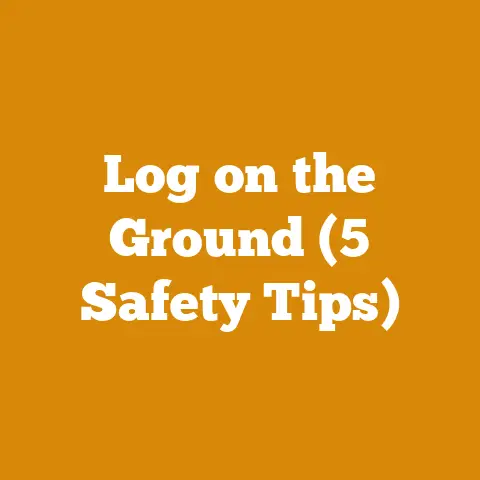Why Does My Chainsaw Cut at an Angle (5 Fixes)
As the weather begins to warm and the days grow longer, many of us are eager to get outside and tackle those long-awaited projects.
Whether it’s clearing out brush, trimming trees, or stocking up on firewood for the next winter, having a chainsaw that cuts straight is crucial.
But what do you do when your trusty chainsaw starts to carve its own path, veering off at an angle?
Let’s explore this issue and discover how to get your chainsaw slicing straight again.
My Chainsaw Chronicles
Let me take you back to a time when I spent an entire weekend fighting with my chainsaw.
I was trying to prepare for a backyard bonfire, but every log I cut ended up looking like a wedge of cheese.
It was a frustrating experience!
But through trial and error, some guidance from seasoned pros, and a bit of online research, I learned how to fix this pesky problem.
Hopefully, my story and insights can save you some headaches.
Getting to the Root of the Problem
When a chainsaw starts cutting at an angle, several factors could be at play.
Understanding these can help you pinpoint the exact cause.
- Chain Wear and Tear
Chains endure a lot of stress. Over time, they can wear unevenly, causing the saw to drift. - Bar Damage A bent or damaged guide bar can steer the chain in the wrong direction.
- Improper Chain Tension
Tension that’s too loose or too tight can lead to crooked cuts. - Uneven Teeth
If one side of the chain’s teeth is sharper or longer than the other, it will pull to one side. - Incorrect Sharpening
Even a slight mistake here can throw off your cut.
Step-by-Step Fixes for an Angled Cut
1. Inspect and Replace the Chain
Step 1: Visual Inspection
Carefully examine the chain for signs of wear or damage.
Look for broken links or bent teeth.
Step 2: Replacement
If you find significant wear, replace the chain with the correct model for your saw.
This is vital for safety and performance.
Step 3: Regular Maintenance
Keep your chain clean and lubricated.
A well-maintained chain lasts longer and cuts better.
2. Examine and Repair the Bar
Step 1: Check for Straightness
Lay the bar on a flat surface.
If it wobbles or looks bent, it may need replacing.
Step 2: File Imperfections
Minor nicks can be filed out using a flat file.
Be gentle and ensure even filing across the bar.
Step 3: Bar Replacement
If damage is severe, replace the bar.
Using a damaged bar can lead to more significant problems down the line.
3. Adjust Chain Tension Properly
Tension impacts how well the chain sits on the bar.
- Check Before Use: Always check tension before starting your chainsaw.
- Proper Adjustment: Loosen the nuts slightly, then turn the tensioning screw until the chain is snug but not overly tight.
- Regular Checks: Recheck tension after prolonged use, as heat can expand materials and loosen the chain.
4. Sharpen Teeth Evenly
Consistency is key when sharpening your chain.
- Use Proper Tools: Invest in a quality file guide to ensure even sharpening.
- Count Your Strokes: Apply the same number of strokes to each tooth.
- Check Your Angles: Use a protractor or guide to maintain consistent angles on each tooth.
5. Balance Your Stance and Technique
It’s not just about your tool; it’s also about how you use it.
- Firm Grip: Hold the saw with both hands firmly.
- Steady Pressure: Let the saw do most of the work; avoid forcing it through the wood.
- Standing Position: Stand with feet apart for balance and position yourself to guide the saw straight through cuts.
Safety First!
Chainsaws are powerful, and safety should always be your priority.
- Wear Protective Gear: Always wear gloves, goggles, ear protection, and sturdy clothing.
- Inspect Before Use: Make sure all parts are in good working order before starting.
- Work in Clear Spaces: Clear your work area of debris and ensure no one is near when you’re cutting.
Prerequisites and Required Materials
Before you start fixing your chainsaw, gather these essentials:
- New chain (if needed)
- File guide
- Round and flat files
- Chainsaw bar wrench
- Personal protective equipment (gloves, goggles, ear protection)
Tips and Tricks for Optimal Performance
- Routine Maintenance: Keep up with regular maintenance tasks such as cleaning and lubrication.
- Watch for Symptoms: Pay attention to changes in cutting performance; they often indicate underlying issues.
- Seek Professional Help: If you’re unsure about any repairs, consult a professional to avoid further damage or injury.
Common Questions and Concerns
Q: Why does my chainsaw keep veering off?
A: Often due to uneven teeth or a bent bar; ensure both are in optimal condition.
Q: How often should I sharpen my chainsaw?
A: After every few uses or whenever you notice performance drops.
Troubleshooting Tips
If your chainsaw continues to cut at an angle despite these efforts:
- Double-check each component for hidden damage.
- Ensure compatibility with replacement parts.
- Consult with an experienced technician if necessary.
Conclusion
Dealing with a chainsaw that cuts at an angle can be frustrating, but with these tips and tricks, you’ll have it running straight in no time.
Remember always to prioritize safety and regular maintenance to keep your tool in top condition.
Best of luck with your outdoor projects!
FAQs
Q: Can I fix a bent bar myself?
A: You might be able to fix minor bends with careful filing, but major bends require replacement.
Q: What if my chain is new but still cuts crooked?
A: Ensure proper tensioning and that all teeth are evenly sharpened.
Q: Is it worth repairing an old chainsaw?
A: Consider the cost of parts versus purchasing a new one; sometimes investing in new equipment is more cost-effective.
With these insights, you’re well-equipped to tackle any angled cutting issues.
Enjoy your projects with confidence!






